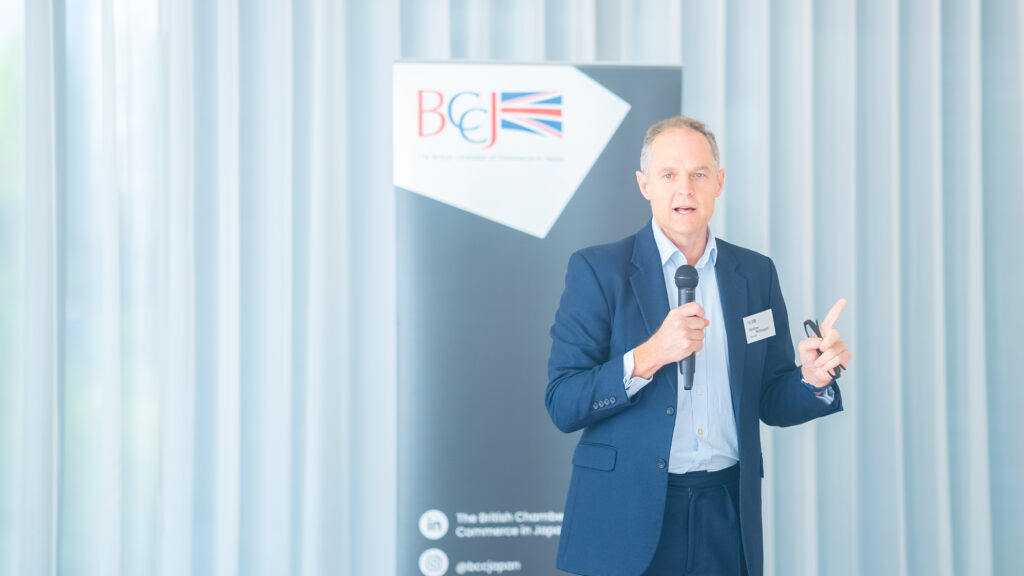Member? Please login
Corporate Sustainability Reporting Directive in Focus

Written by Sterling Content
August 23, 2024
Past Event Round Ups
The Corporate Sustainability Reporting Directive (CSRD), brought into force in 2023 by the European Union (EU), is designed to strengthen and modernise the rules on social and environmental reporting for large companies and listed SMEs.
Exploring the implications of this new law was the topic of a recent British Chamber of Commerce event, featuring keynote speaker Heather Prosser, managing director and head of sustainability at consultancy Sodali Japan.
For Japanese companies with operations or subsidiaries in the EU or engaged in trade with the EU, conforming with the CSRD is “imperative,” according to Sodali. Disclosure is required between 2026 and 2029 depending on the size of the business, but businesses should start preparing now, Prosser said.
“This regulatory change is going to change the way we look at sustainability. These changes have happened in Europe but are impacting the whole world,” she said. “CSRD is a pivotal regulation in enhancing the transparency and comparability of sustainability-related disclosures among EU-listed companies. Sustainability reporting will be the subject of the same level of rigour and control as financial reporting.”
Replacing the 2014 Non-financial Reporting Directive (NFRD) the CSRD will expand on the NFRD’s 11,000 public EU companies to include nearly 50,000 companies, including private companies such as the EU subsidiaries of Japanese companies, with as many as 10,000 foreign companies affected.
The CSRD introduces mandatory reporting requirements for a broader range of sustainability factors, with more than 1,000 potential disclosure points. It includes concepts such as double materiality, limited assurance and electronic tagging, aiming for harmonised reporting standards across the EU.
Prosser said the changes mark an evolution of sustainability reporting, from voluntary disclosures to a more transparent and consistent approach.
“There’s been a compliance journey where things have started to grow and change from an overall aim of making sustainability information clearer and easier to understand,” she said.
“When I started working in sustainability, a lot of information was qualitative. And while there is a space for qualitative information in sustainability, it’s very hard to compare apples for apples … the purpose of these regulations is to clear this up.”
Prosser said the Japanese government is “watching” this very carefully to see which aspects go well and what might be integrated into Japan in the future.
“We think this journey will not stop in Europe,” she said.
Non-EU companies’ reporting options
Non-EU companies have three basic options for adjusting to the new regime: publish a CSRD report specific to the EU subsidiary, undertake a consolidated report for all European subsidiaries, or compile a consolidated global report. Each option has its pros and cons, with the best measure depending on the type of company and its scope of operations.
Prosser said the scope of work required in reporting could take two to three years, suggesting firms start the process as early as possible.
“If you are a company that has a small exposure, doing a European entity-only report is probably a great way to go. Work out some of those challenges now so that when you need to expand that reporting you have processes in place to make sure you are not only compliant but also able to utilise this in the best possible way,” she said.
The regime includes a range of European Sustainability Reporting Standards (ESRS), covering such areas as climate change, pollution, water and marine resources, biodiversity and ecosystems, resource use and circular economy, and affected communities.
For Japanese companies, Prosser recommends first conducting a thorough “gap analysis” to assess current sustainability reporting compared to the EU’s requirements, followed by stakeholder engagement to understand their expectations regarding sustainability disclosures.
The next step is a double materiality assessment considering not only ESG factors material to a business but also a firm’s impact on society and the environment. The framework entails “robust” data collection and management systems, together with an appropriate reporting framework and integration with financial reporting. The final step is obtaining assurance and verification.
Yet while the new regime will undoubtedly add “costs and time” to companies’ sustainability reporting, Prosser argued there is an opportunity for differentiation by compiling two separate reports: one for the regulators and another for general stakeholders.
“Your opportunity is not only to meet those disclosure requirements, but to tell your sustainability story in a compelling way—and to be frank, most companies don’t,” she said.
The good news for companies already reporting on sustainability is that “you don’t need to recreate the wheel. Look at all the existing disclosures and processes you have and figure out what’s missing,” she added.
“If you have a robust programme for sustainability already, maybe you just need one to two years, which should be enough for most large companies who have already been down a lot of this road.
“If you’re a smaller company or SME who hasn’t been doing this, you will need to start with the scoping analysis and focus more on the scope of your data and where your gaps are. In completing that, you’re going to make sure it is auditable data.”
Prosser concluded by urging companies to examine their scope of operations, creating a “feasible plan” for implementation.
“This is a big compliance issue: it can’t stay in a silo. You’re going to need to include procurement, R&D and legal—this is a team sport,” she said.







